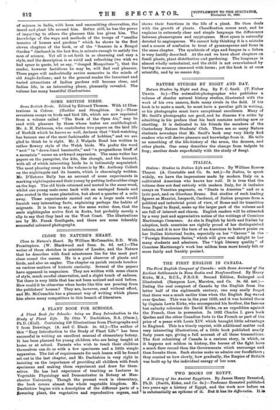A PLANT BOOK FOR SCHOOLS.
A Plant Book for Schools: being an Easy Introduction to the Study of Plant Life. By Otto V. Darbishire, B.A. (Oxon.), Ph.D. (Kiel). Containing 108 Illustrations from Photographs and 7 from Drawings. (A. and C. Black. 2s. 6d.)—The author of this "Easy Introduction to the Study of Plant Life" has been successful in writing an excellent manual of elementary botany. It has been planned for young children who are being taught at home or at school. Parents who wish to teach their children themselves can do so with a few specimens and a little simple apparatus. The list of requirements for each lesson will be found set out in the last chapter, and Mr. Darbishire is very right in insisting on the importance of providing all children with fresh specimens and making them experiment and draw for them- selves. He has had experience of teaching as Lecturer in Vegetable Physiology and Demonstrator in Botany at Man- chester University. Though the present work is elementary, the book covers almost the whole vegetable kingdom. Mr. Darbishire begins with a description of the different parts of a cowering plant, the vegetative and reproductive organs, and
shows their functions in the life of a plant. He then deals with the growth of plants. Classification comes next, and he explains in extremely clear and simple language the differences between phanerog,ams and cryptogams. Most space is naturally devoted to angiosperms. We cannot help thinking it is a mistake and a source of confusion to treat of gymnosperms and ferns in the same chapter. The symbiosis of alga and fungus in a lichen is very lucidly described. At the end we have short chapters on fossil plants, plant distribution and gardening. The language is almost wholly untechnical, and the child is not overwhelmed by having its memory crammed with terms; yet the book is at once scientific, and by no means dry.
































































 Previous page
Previous page